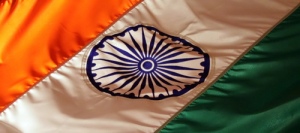Saluting the Chakra: Passing Down Patriotism to Desi Youth
Last weekend, I joined my mother for her biweekly class in Jacksonville. She spends her entire Saturday teaching young children, and normally, I’m astounded by her patience with the kids who can hardly keep their hands straight or do a proper aramandi (half-squatting position). But last Saturday, I was actually surprised at the children’s patience and maturity, because she was teaching them a patriotic piece.
Since India’s fiftieth year of independence, patriotic dances, skits and musical numbers have become increasingly prevalent at Indian cultural shows. It is the immigrants’ way of paying homage to the motherland from their new country. What’s striking is that many of these pieces are performed by second-generation youth (not even college students). It seems puzzling that a generation consisting mainly of kids born and raised in the U.S. feel it appropriate to be singing and dancing to songs such as “Maa Tujhe Salaam,” “Vande Maataram,” and “Jayati, Jayati Bharata Mata,” all which pay tribute to the mother country. How is it even possible for these kids to feel patriotic sentiments for a country that many of them have never even visited yet? At the high-school or college level it is understandable because most children have visited India at least once by this age, but at a very early age, how is patriotism for India possible?
The trend I’ve observed is that children are usually nudged into these dances by elders, and soon, they internalize these sentiments and begin to associate themselves as comfortably with the chakra as they do the stripes and stars. Sporting green, white and saffron on Aug. 15 becomes equally as important as wearing red, white and blue on the Fourth of July — but why?
Sunaina Marr Maira, author of “Desis in the House: Indian American Youth Culture in New York City,” says the nostalgia imbibed in the youth despite the presence of concrete memories is based on “recreated popular memory based on a myth of pure origins” a presumed missing link “that is historical, cultural, personal.” Of course, the music for these dances is in itself powerful and moving, and it probably adds to the feeling of patriotism and nostalgia for the mother country (Take for example A.R. Rahman’s “Vande Maataram”). Even without knowing the meaning of the lyrics, children learn to feel pride and longing for the country in which their parents grew up. Maira attributes the nostalgia to the predicated “absence [of] a cultural anchor that is both missing and missed, “[and the assumption] of an earlier time of cultural wholeness that is now at the risk of fragmentation, if not dissolution.”
Children in the diaspora, while they do not have the same attachment to the homeland as their parents do, recognize political ties with both nations, even if they are not technically citizens of both. They pay closer attention to the evening world news if/when India is mentioned. Often, when they reach college, they orchestrate volunteer efforts which somehow give back to the uneducated, impoverished, or at-risk youth of India rather than other countries. Perhaps this is also their way of fulfilling their dharma as a citizen of the world.
My own friends, who have been born and raised here in America, have told me about their rewarding experiences over summers helping the disadvantaged of India. My friend, Anushree Nakkana, a University of Florida anthropology major, recently documented the lack of educational opportunities for underprivileged children in Hyderabad. Divya Arora, a University of South Florida medical student, also made a special trip to India, to provide immunizations and medication to the impoverished.
Conversely, there are those in India saying students in India are abandoning their sentiments of patriotism, in an effort to become more Westernized. Rishabh Srivatsava on his blog, “Jai Hind: Proud to be Indian” shows disappointment toward the youth of India, and their lack of interest to bring India to the forefront of the global stage.
“They give reason that there is no infrastructure in our country, there are hardly any avenues, scope to make it big and fulfill one’s ambition. This might be true, but isn’t it our responsibility to facilitate such an environment in our country?”
So why is it that the children outside of India (at times) show more patriotism for India than the youth in the motherland, itself? Both have grown up listening to stories of the audacity (and antics) of Mohandas Gandhi, the fastidiousness of Jawaharlal Nehru, and the poetry of Rabindranath Tagore. But I think much of the desi loyalty to India stems from the understanding of the sacrifice their parents made in moving to America from their homes. The Mira Nair film based on the Jhumpa Lahiri novel, “The Namesake,” portrays this sentiment movingly. Second-generation Indian Americans ultimately realize that their parents risked losing the culture of an entire nation, the culture of several generations of ancestors, in an effort to give their children the opportunity to pursue a frontier of educational and professional possibilities. It is from there that their patriotism for India stems.

January 15, 2011 at 2:39 am
its really too gd. n nery true facts whtever u mentioned above.
i myself working on a skit 4 my students in 4th 4 d republic day celebration… if have any small skit or any new idea through which we can awake n arise our indians. do reply…
looking 4ward 4 ur reply..